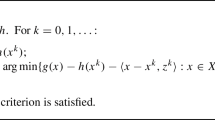Abstract
In this paper, we present a power penalty function approach to the linear complementarity problem arising from pricing American options. The problem is first reformulated as a variational inequality problem; the resulting variational inequality problem is then transformed into a nonlinear parabolic partial differential equation (PDE) by adding a power penalty term. It is shown that the solution to the penalized equation converges to that of the variational inequality problem with an arbitrary order. This arbitrary-order convergence rate allows us to achieve the required accuracy of the solution with a small penalty parameter. A numerical scheme for solving the penalized nonlinear PDE is also proposed. Numerical results are given to illustrate the theoretical findings and to show the effectiveness and usefulness of the method.
Similar content being viewed by others
References
Wilmott, P., Dewynne, J., and Howison, S., Option Pricing: Mathematical Models and Computation, Oxford Financial Press, Oxford, UK, 1993.
Black, F., and Scholes, M., The Pricing of Options and Corporate Liabilities, Journal of Political Economy, Vol. 81, pp. 637–659, 1973.
Cox, J. C., Ross, S., and Rubinstein, M., Option Pricing: A Simplified Approach, Journal of Financial Economics, Vol. 7, pp. 229–264, 1979.
Hull, J. C., and White, A., The Use of Control Variate Technique in Option Pricing, Journal of Financial Economics Quantitative Analysis, Vol. 23, pp. 237–251, 1988.
Barles, G., Convergence of Numerical Schemes for Degenerate Parabolic Equations Arising in Finance Theory, Numerical Methods in Finance, Edited by L.C.G. Rogers and D. Tallay, Cambridge University Press, Cambridge, UK, pp. 1-21, 1997.
Courtadoh, G., A More Accurate Finite-Difference Approximation for the Valuation of Options, Journal of Financial Economics Quantitative Analysis, Vol. 17, pp. 697–703, 1982.
Schwartz, E., The Valuation of Warrants: Implementing a New Approach, Journal of Financial Economics, Vol 13, pp. 79–93, 1977.
Vazquez, C., An Upwind Numerical Approach for an American and European Option Pricing Model, Applied Mathematics and Computation, Vol. 97, pp. 273–286, 1998.
Allegretto, W., Lin, Y., and Yang, H., Finite-Element Error Estimates for a Nonlocal Problem in American Option Valuation, SIAM Journal on Numerical Analysis, Vol. 39, pp. 834–857, 2001.
Zvan, R., Forsyth, P. A., and Vetzal, K. R., Penalty Methods for American Options with Stochastic Volatility, Journal of Computational and Applied Mathematics, Vol. 91, pp. 199–218, 1998.
Forsyth, P. A., and Vetzal, K. R., Quadratic Convergence for Valuing American Options Using a Penalty Method, SIAM Journal on Statistical and Scientific Computing, Vol. 23, pp. 2095–2122, 2002.
Bensoussan, A., and Lions, J. L., Applications of Variational Inequalities in Stochastic Control, North-Holland, Amsterdam, Holland, 1982.
Glowinski, R., Numerical Methods for Nonlinear Variational Problems, Springer Verlag, New York, NY, 1984.
Rubinov, A. M., and Yang, X. Q., Lagrange-Type Functions in Constrained Nonconvex Optimization, Kluwer Academic Publishers, Dordrecht, Holland, 2003.
Yang, X. Q., and Huang, X. X., A Nonlinear Lagrangian Approach to Constrained Optimization Problems, SIAM Journal on Optimization Vol. 14, pp. 1119–1144, 2001.
Fletcher, R., Practical Methods of Optimization, Wiley and Sons, New York, NY, 1987.
Brenner, S. C., and Scott, L. R., The Mathematical Theory of Finite-Element Methods, Springer Verlag, New York, NY, 1994.
Wang, S., A Novel Fitted Finite-Volume Method for the Black-Scholes Equation Governing Option Pricing, IMA Journal of Numerical Analysis, Vol. 24, pp. 699–720, 2004.
Haslinger, J., and Miettinen, M., Finite-Element Method for Hemivariational Inequalities, Kluwer Academic Publishers, Dordrecht, Holland, 1999.
Miller, J. J. H., and Wang, S., A New Nonconforming Petrov-Galerkin Method with Triangular Elements for a Singularly-Perturbed Advection-Diffusion Problem, IMA Journal of Numerical Analysis, Vol. 14, pp. 257–276, 1994.
Miller, J. J. H., and Wang, S., An Exponentially Fitted Finite-Element Volume Method for the Numerical Solution of 2D Unsteady Incompressible Flow Problems, Journal of Computational Physics, Vol. 115, pp. 56–64, 1994.
Varga, R. S., Matrix Iterative Analysis, Prentice-Hall, Englewood Cliffs, New Jersey, 1962.
Author information
Authors and Affiliations
Additional information
Communicated by F. Giannessi
This work was partially supported by a research grant from the University of Western Australia and the Research Grant Council of Hong Kong, Grants PolyU BQ475 and PolyU BQ493.
Rights and permissions
About this article
Cite this article
Wang, S., Yang, X.Q. & Teo, K.L. Power Penalty Method for a Linear Complementarity Problem Arising from American Option Valuation. J Optim Theory Appl 129, 227–254 (2006). https://doi.org/10.1007/s10957-006-9062-3
Published:
Issue Date:
DOI: https://doi.org/10.1007/s10957-006-9062-3




